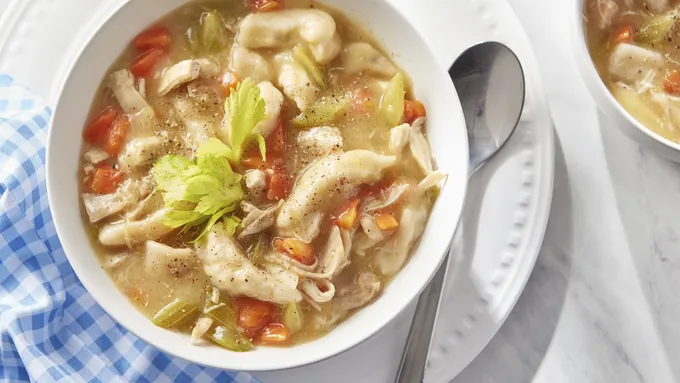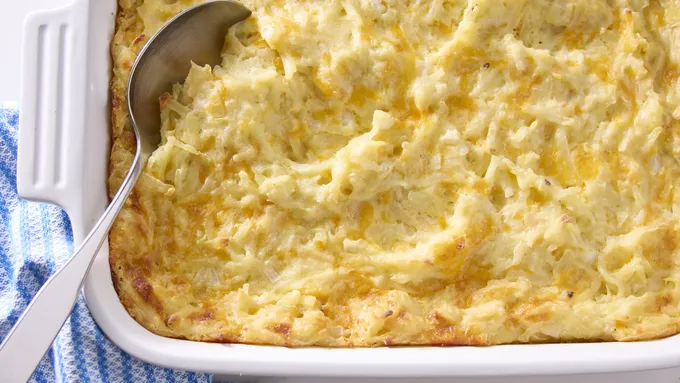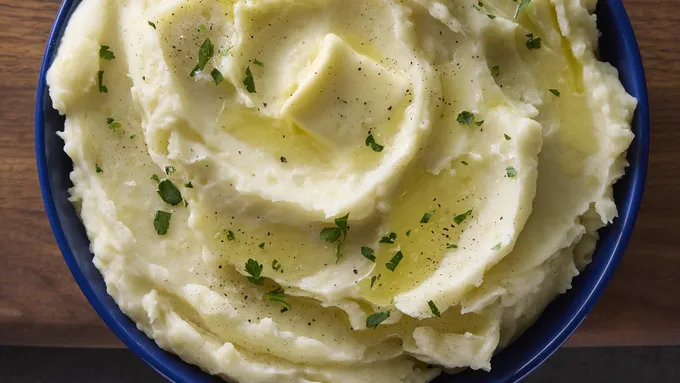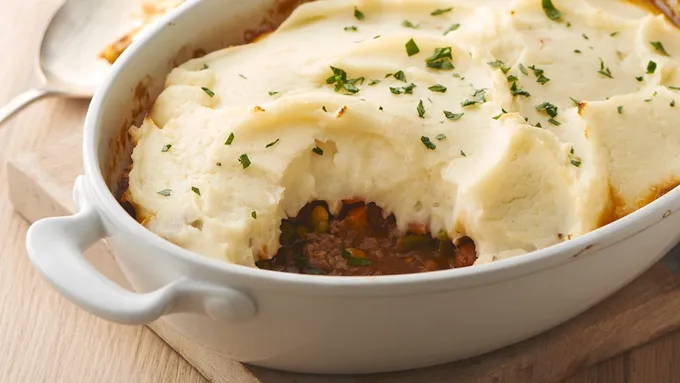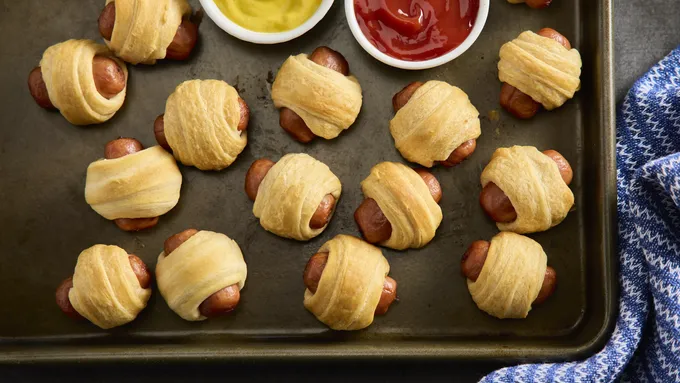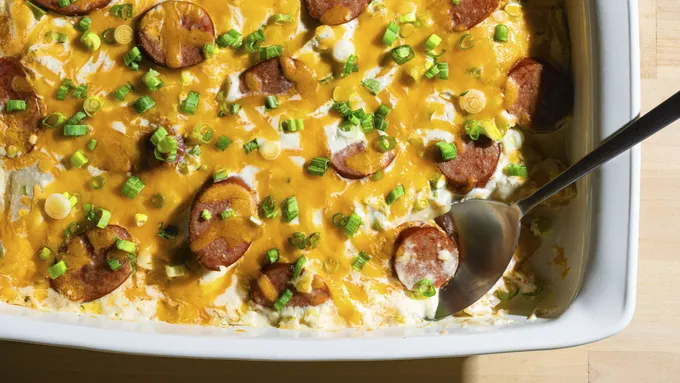Homemade Potato Chips
Potatoes are popular everywhere, and for good reason! These crispy, crunchy, salty slices of perfection have been around since at least the early 19th century. While the original inventor of the potato chip is up for debate, they first became popular in the United Kingdom and the United States.
Whether called chips or crisps, this versatile version of basic potatoes feels at once familiar and decadent, as comfortable paired with jarred French onion dip as crème fraîche and caviar.
We tossed these classically-fried chips in plain salt, but it’s hard to think of a topping that doesn’t work with a chip! In addition to plain salt, try adding a little smoked paprika, garlic powder, or onion powder. Or use dried herb blends and spice mixes like herbes de Provence, za’atar, barbecue seasoning, lemon pepper blend, curry powder, or furikake seasoning.
Try drizzling salted chips with your favorite vinegar. Malt vinegar is the classic choice, but cider vinegar, sherry vinegar, rice vinegar, and white balsamic vinegar can add interesting flavors that you can vary based on your menu.
Feeling super fancy? A bit of white truffle oil and a sprinkle of grated Parmesan cheese can magically elevate the humble chip to a showstopping appetizer.
No matter how you top them, you’ll love the crispy, crunchy deliciousness of these homemade fried potato chips.
Choosing Your Potatoes
Russet or Idaho potatoes have a high starch content, perfect for frying. Unlike creamy and waxy versions like Yukon golds, fingerlings, and red potatoes, these larger starchy potatoes are ideal for homemade potato chips.
Whether you peel the potatoes or not, there are a few qualities to look for when shopping for your potatoes. Select potatoes that are free from eyes and black spots, as they may extend deeper into the flesh than you might expect. Avoid potatoes with a greenish tint. This green color is from exposure to sunlight, but it can also cause the potato to taste bitter and may be harmful in large amounts. Larger potatoes are easier to peel and cut, but if you plan to use a food processor for slicing, be sure to choose potatoes that will fit through the feed tube of the machine.
How to Slice Potato Chips
Thinly slicing the potatoes is the key to successful homemade potato chips. If you’re worried about your knife skills, opt for a mandoline slicer instead, or use a food processor fitted with the slicing blade.
Since potatoes can stick to the blade of a knife, go slowly and be sure to remove each slice before making the next one. A santoku knife has indentions on the blade, which create an air gap as you slice. This can reduce the amount of sticking.
To use a mandoline slicer, adjust the blade to 1/16th inch. Firmly secure the pusher in one end of the potato, and place the other end perpendicular to the slicer. Make quick slices without lifting the potato off the slicer.
A food processor will provide the fastest, easiest, most uniform slices. If the potato is too long to fit inside the feed tube, cut in half crosswise and place cut side down in the tube, taking care to keep the potato standing up straight for perfect slices. If the potato is slightly too large, use a peeler to shave it down just enough to fit.
However you cut them, adding them to the cold water as you work prevents them from turning brown during prep and also removes a bit of the starch, keeping them from sticking together while frying the potato chips.
How to Make Fried Potato Chips
Now that you know exactly what kind of potatoes to purchase and what tools you’ll need, you just need to know how to make potato chips!
Slice the Potatoes
Slicing the potatoes as thinly as possible ensures fast and even cooking. You can use a knife, mandoline slicer, or food processor for thin, even potato chips.
Soak the Slices in Cold Water
As you cut the potatoes, add them to a bowl of cold water to prevent browning and remove a bit of starch from the potatoes. Just be sure to dry them thoroughly before adding to the hot oil. This prevents dangerous splattering.
Fry the Potatoes
Our potato chips recipe calls for a Dutch oven for frying, but you could also use a countertop deep fryer. Attach a candy or deep frying thermometer to the side of the Dutch oven and be sure the oil reaches 300°F before adding each batch of potato slices. Fry each batch about 5 minutes, or until golden brown, stirring often to prevent them from sticking together.
Drain and SeasonLift the potatoes from the hot oil with a spider or slotted spoon, letting the oil drip off, then drain on paper towels. Toss with salt, and serve while hot.
How to Store Leftover Potato Chips
When you make potato chips yourself, it’s unlikely you’ll have leftovers! But if you do, they can be saved for later once properly stored. Cool them completely, then transfer to an airtight container or ziptop storage bag and store in a cool, dry place up to 3 days.
Since these freshly fried potato chips don’t contain the preservatives common in packaged chips, they won’t last as long as the commercial versions. Over time, they will soften slightly. But the best way to enjoy these delicious homemade fried potato chips is hot and fresh!
What to Serve With Homemade Chips
Now that you know how to fry potato chips (or potato crisps in the U.K. and Ireland), what should you serve with them?
The real question is what can’t you serve with them! Of course you’ll want to include them for big summer spreads with biscuit burgers and barbecue pork chops. But adding these lovingly prepared chips to your favorite baked fish, grilled spicy chicken, or toasted beef and mozzarella sandwiches makes a simple meal spectacular. Humble potato chips fit perfectly on most casual lunch or dinner plates, but hot, fresh potato chips take any meal up a notch. Still, we have to have a favorite. The best pairing? Caramelized onion dip!
Frequently Asked Questions
Wondering why sometimes chips fold, while other times they stay flat? It depends on many factors, from oil temperature to rate and speed of stirring.
The method for making homemade potato chips is closer to the standard kettle chip method than to commercially processed chips. With small batch-cooked potatoes, the temperature of the oil drops once each batch of potatoes is added, creating a slight inconsistency in cooking. Also, it’s harder to achieve razor-thin chips with a knife or other home kitchen equipment. This means chips cook a little unevenly compared to store-bought chips, and because of that, sometimes they fold. You can avoid some folding by stirring gently and constantly as the chips fry.
Fortunately, if you have some folded chips, you probably won’t have a hard time finding fans. Many people prefer the added crunch, sturdiness, and extra flavor that come with a folded chip.
One of the problems many people encounter when making homemade potato chips is sticking. Russets, the best potatoes for making potato chips, are naturally starchy and sticky, so it’s necessary to take a couple of steps to prevent them from fusing together during the frying process.
Soaking the potato chips in water removes some of the starch from the potatoes, which is one reason they can stick together while frying.
Stirring the chips gently throughout the frying process also helps prevent chips from sticking together. If you notice a few chips sticking together while frying and stirring doesn’t help to separate them, use a pair of long tongs or chopsticks to separate the rogue chips.
Obviously, when you fry your own potato chips at home, you’re hoping for hot, crispy, salty pieces of heaven. If they don’t deliver on that, here’s how to troubleshoot.
Type of Potato: Did you use a starchy Russet or Idaho potato? Other types of potatoes are waxier and don’t fry up as crispy and crunchy as the starchier varieties do.
Thickness: Were your potato slices too thick? Thicker slices will take longer to cook and might even require two separate fries, much like French fries, in order to cook the potato in the center and get the outside of the chip to a delicious golden brown.
Time and Temperature: Was your oil hot enough? Remember to return oil to 300°F before frying each batch of potatoes. Did you cook them for long enough? Be sure to cook all chips until evenly golden brown before removing. It’s better to have a few slightly overcooked chips than a few that are undercooked.
Storing: Did you cool them completely before storing? Hot potato chips will still release steam as they cool, so sealing them in a bag or container while hot will trap that water and make them soggy.
If you bought a 5lb bag and have leftover uncooked potatoes you would like to use, try making homemade mashed potatoes, a cheesy potato casserole, or oven-roasted potatoes are an easy side any night of the week.
For a classic thin and crunchy potato chip, nothing beats the traditional method of deep-frying. We won’t lie – thinly-sliced potatoes create the most possible surface area to absorb oil when frying, so the resulting chips contain quite a bit of fat. But that’s why they taste so good!
The truth is it’s almost impossible to recreate the delicious taste and texture of deep-fried potato chips without deep-frying them. Even if you coat the raw potato slices in oil to roast or air fry them, they won’t have the same even color, texture and flavor of fried chips. And most commercially prepared baked chips add more salt and other seasonings to make up for what they lack in texture and flavor, so you still have a less desirable chip, but it’s super salty.
We love all potatoes. We’re not judging baked chips, since it’s hard to make any kind of potato dish taste bad. But we think it’s better to enjoy a few extremely delicious chips than tons of less- than-fabulous ones.
Homemade Potato Chips
- Prep Time 25 min
- Total 35 min
- Ingredients 4
- Servings 4
Ingredients
- 1 lb russet potatoes (about 2 large), peeled
- 2 quarts cold water
- 2 quarts canola oil
- 1/4 teaspoon salt
Instructions
-
Step1Slice potatoes 1/16-inch thick.
![]()
-
Step2Place water in large bowl. Add potato slices to the water. Let stand 10 minutes. Drain potato slices in colander; shake to remove excess water. Pat dry with paper towels.
![]()
-
Step3In 5-quart Dutch oven, heat oil to 300°F. Cook potatoes in 2 batches. Add half of potato slices, and cook 4 to 7 minutes, stirring frequently with wire mesh spider strainer or slotted spoon, until potatoes are golden brown.
![]()
-
Step4Transfer chips to large bowl lined with paper towels; sprinkle with 1/8 teaspoon of the salt and toss to coat. Repeat with remaining potatoes.
![]()
-
Step5Serve immediately, or allow to cool completely before transferring to resealable food-storage plastic bag.
Nutrition
Nutrition Facts
Serving Size: 1 Serving
- Calories
- 360
- Calories from Fat
- 270
- Total Fat
- 30g
- 46%
- Saturated Fat
- 2g
- 11%
- Trans Fat
- 0g
- Cholesterol
- 0mg
- 0%
- Sodium
- 150mg
- 6%
- Potassium
- 360mg
- 10%
- Total Carbohydrate
- 20g
- 7%
- Dietary Fiber
- 1g
- 6%
- Sugars
- 2g
- Protein
- 1g
% Daily Value*:
- Vitamin A
- 0%
- 0%
- Vitamin C
- 10%
- 10%
- Calcium
- 0%
- 0%
- Iron
- 0%
- 0%
Exchanges:
0 Starch; 0 Fruit; 1 1/2 Other Carbohydrate; 0 Skim Milk; 0 Low-Fat Milk; 0 Milk; 0 Vegetable; 0 Very Lean Meat; 0 Lean Meat; 0 High-Fat Meat; 6 Fat;Carbohydrate Choice
1Recipe Tips






